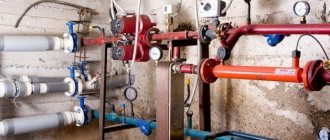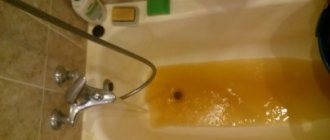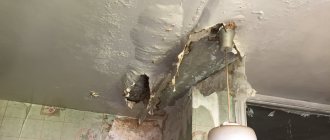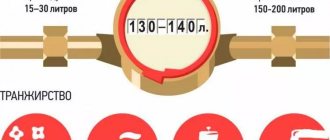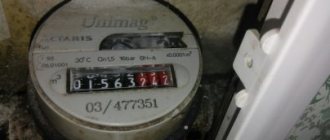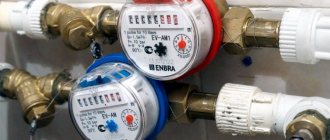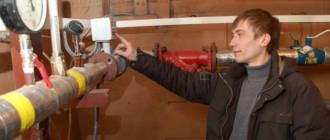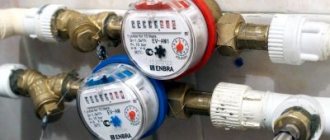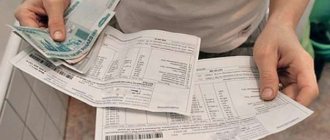Is it necessary to install a water meter in an apartment or private house?
Water meters are not yet an urgent need because:
- The laws have not yet addressed the issue head-on: establish, otherwise there will be a fine and administrative liability.
- In some cases, installing a control panel is not profitable: if one person is registered in an apartment, but five live, it is more profitable to pay according to the standards.
However, legislation is systematically changing, and rational use of resources and optimization of consumption calculations are becoming a priority.
The use of water meters is not only favorable from a legislative point of view, but also economically beneficial for the user.
Legal requirements
The installation of metering devices, their commissioning and consumption calculation standards according to their data are regulated by legislative acts:
- No. 102-FZ (from 2008) - regulates the general characteristics of PU, prescribes the rights of users to the accuracy of measurements when calculating utility services.
- No. 416-FZ (of 2011) - prescribes the procedure for legal interactions in the field of water supply.
- Government Decree (GD) of the Russian Federation No. 776 (of 2013) regulates the rules for accounting for water consumption and wastewater disposal using water meters.
- RF PP No. 306 (from 2006) - it provides water consumption standards.
- RF PP No. 354 (of 2011) – calculation of payment for the resource consumed according to the indications of the PU.
- Federal laws regulating the rules for measuring consumed energy resources, installation and introduction into use, the rights of citizens to the accuracy of measurements (No. 102-FZ and No. 261-FZ, dated 2008 and 2009, respectively).
- Order of the Ministry of Energy, which strongly recommends the use of PU for measuring consumption (No. 178, effective April 16, 2010).
- RF PP No. 344 (of 2013) - increases increased calculated coefficients for citizens who do not install PU without good reason.
Rules for installing water meters in an apartment
Regulations regulating the use and installation of metering devices are mandatory for all participants - users, resource providers and service companies.
Requirements for metering devices. Devices manufactured in accordance with GOST R 50601 and 50193 and included in the register of measuring instruments are allowed for installation. The diameters of the device’s pipes must correspond to those common in the Russian Federation. The design of the device must exclude the technical or physical possibility of changing the readings.
Technical requirements for the operation and installation of water meters in the apartment. The rules dictate:
- where to install water meters - the location of the devices should be accessible to both the resource supplier and the user himself, and the room temperature should not fall below 5 °C;
- sealing the device, the procedure is free for the consumer;
- registration of the installed device;
- regular transmission of evidence to regulatory authorities;
- verification, repair or replacement of the meter by the homeowner;
- for organizations carrying out water supply systems, the obligation to install, replace and verify water meters at the request of the consumer and at his expense, but with possible installment payments;
- service companies must have the appropriate license to carry out work on installing metering devices.
The homeowner should remember that neither the organizations supplying water resources nor the management of the condominium can impose any meter models or services. If the housing is considered dilapidated, the project for installing a water meter must be approved by the responsible organizations.
Benefits from using water meters
Knowledge of tariffs and consumption standards will help you calculate how profitable it is to pay for water supply services by meter.
For example, in Moscow these indicators are:
- hot water, r./m3 - 198.19;
- cold water, r./m3 - 40.48;
- water disposal, r./m3 - 29.57.
The monthly usage rates here are 6.935 m3/person. for cold water and 4.745 m3/person. for hot. Simple calculations will help you compare monthly payments according to PU indicators and according to standards.
Let’s take the average usage data for a family of three:
| Type of service | According to PU | According to standards |
| HVS | 5,5*40,48=222,64 | 6,935*3*40,48=842,186 |
| DHW | 5,2*198,19=1030,588 | 4,745*3*198,19=2821,235 |
| Water disposal | (5,5+5,2)*29,57=316,399 | (6,935+4,745)*3*29,57=1036,133 |
| Result: | 1,569.627 rubles | 4,699.55 rubles |
As can be seen from the calculations, the use of water meters can reduce the cost of services by three times.
Even though the cost of a water meter and its installation makes adjustments to expenses (plus mandatory periodic verification), the use of PU water is inappropriate only if many more people live in the room than prescribed. And you can install the PU yourself.
We’ll talk about the benefits in this article, and about self-installation here.
Is it possible to install a water meter yourself?
The law establishes that owners of residential premises are required to install water meters in their apartments. The installation deadline for the meter is periodically shifted, but sooner or later it will be necessary to do it.
There are no restrictions on doing it yourself. However, if you do not know how to install water meters in an apartment, then you should contact one of the service companies and entrust this task to them by specialists. Our article will focus on how to install a measuring device yourself or with the help of a specialist and what may be required for this.
Is it profitable to install a meter?
Many Russians still cannot decide whether it is profitable to install a water meter. The main difficulty is that such a step is not very beneficial for citizens living alone.
As a result, you will have to pay more than if you did not have a measuring device.
This option is convenient for people who often leave for a long time or when there are more people living in the premises than registered.
The minimum savings when installing a metering device can be from 30%, but most often the amount is reduced several times. For information, it should be noted that the consumption standard per person can be 8-10 cubic meters. In fact, water consumption can be much less - up to 5 cubic meters.
Based on this, the decision to install meters will allow you to significantly save on rent. If there are regularly more people on the premises than registered, then this option is not suitable for saving.
Is it possible to install the device with your own hands and what is the procedure?
Current legislation states that the installation of a water meter is paid for by the owner of the premises. That is, the apartment owner is obliged to buy the device in advance and install it personally or with the help of a specialist. After this, the water meter is sealed by a water utility employee without paying any fee.
You can install a meter yourself, and no one has the right to object to a citizen who has made such a decision. The only drawback may be that you have to do everything yourself. During installation you will need to perform the following steps:
- First you will need to buy a device and the necessary papers.
- Visit the management company and agree on the time and date for turning off the cold/hot water riser for a certain period of time.
- Install the device according to all rules and open the water supply.
- Call a representative of the water utility for subsequent sealing of the document.
- Sign the document on putting the device into use and subsequently submit it for registration of the accounting device.
After all the necessary measures have been completed, you can begin to transfer testimony and pay receipts received by mail.
Features and important points related to the installation of a meter
The first thing a person may need to install a water meter with their own hands is to familiarize themselves with the diagram. In the future, this will allow you to control the process and perform all the necessary actions as correctly as possible. Meters are installed immediately after the riser on a straight section of pipes.
It is important to take into account the features of the metering device, because some devices are mounted strictly in a horizontal position, while others are mounted exclusively in a vertical position. The standard water meter installation diagram includes the following important components:
- a ball valve that screws onto a pipe extending from the riser;
- coarse filter;
- counter;
- wiring
All other parts and accessories can also be installed, but are not required. To eliminate further problems, it is important to make sure that the number in the meter passport exactly matches the number on the device itself. The device must be certified.
When installing the device, there is no need to tighten the connections very tightly, since microcracks will appear, which will subsequently lead to leakage. In the case of steel pipes, welding will have to be used.
During installation, a variety of devices may be required, in particular, sealing tape, shut-off valve, pressure sensor. During installation, care must be taken to ensure that no accidents occur in the future.
Which device is better - electronic or mechanical?
Mechanical water consumption metering devices on an impeller are more in demand. Relatively low cost, simplicity, and therefore reliability of the design and ease of installation are undeniable advantages.
But with the development of technology, electronic models are becoming more attractive . Their advantages:
High accuracy of measurements of consumed water. Digital devices with an LCD screen are especially distinguished in this regard.- A longer period between verifications is 10 years.
- Digital data output – a remote screen makes it easy to take readings. It can be completely hidden under a decorative panel or covered with tiles.
- Transfer of information directly from the water meter to Internet portals for water supply services. Reduces time spent on monthly self-billing and payment. They can be configured automatically in the subscriber’s LAN.
- Possibility of calculation according to several tariffs: digital control units with temperature sensors are calculated according to four tariffs: water up to 40° - according to the coefficient for hot water supply, in the range 40... 44° - according to the tariff 70% of the coefficient for hot water supply, up to 49° - 90% of the coefficient DHW, over 50° - full 100% coefficient for DHW.
Of the minuses:
- high price,
- work on electricity (in most models),
- higher probability of failure compared to the simplest winged PUs,
- The complexity of installing electronic devices is higher than that of mechanical ones.
It makes sense to install an electronic control unit in cases where the temperature of the supplied water often does not meet the standards - there is a chance to save money.
Often such water meters are used in conjunction with the Smart Home system.
Problems during operation and their solutions
During the operation of the water metering unit, some problems may arise. Let's consider their types and possible solutions.
Whatever the problem, it is not recommended to fix the problem yourself. Use the services of specialists - this will save your time and money.
High-quality sealing is the key to long-term service, but do not overdo it. A large amount of winding may cause leakage
Symptoms and corrective measures:
- Water flows poorly through the water meter . The coarse filter may be clogged. It is necessary to call a representative of the management company to eliminate the defect; he is obliged to clean the filter and re-seal it free of charge. Under no circumstances do this yourself; breaking the seal is tantamount to voiding the warranty.
- Broken seal. Don't fix it yourself. Notify the management company as soon as possible. You will have to pay for re-sealing, but this is nothing compared to the fines if the inspector discovers that the seal has been broken. You will have to pay the full amount of the tariff since the last inspection (maybe several years), as well as a fine for missing an application.
- Water passes through the water meter, but the readings are not recorded. The counting or rotor mechanism may have broken down. If you are sure that your water meter is faulty, you have the right to a free unscheduled inspection. This is the case if the warranty period has not expired.
During the inspection period, water payments are calculated based on the average minimum for the region. The inspection can take up to several months; sometimes it is easier to buy a new one.
Don’t delay installing a water meter – it will help you save up to 30% of your monthly payment
Installing individual water meters is becoming an integral procedure in every home; the process is not so much labor-intensive as it is troublesome, but it is completely worth it.
By following the order in the sequence of work on installing a water meter, you not only save about 30% every month, but also have an incentive to use water wisely.
You may also find useful information about the timing of meter verification and the specifics of this procedure.
Where to go to connect?
What is needed to install a water meter? You can install PU water yourself or entrust this issue to a specialist if you have doubts about your own skills.
In both cases, it will be necessary to notify the management company with which the contract for house maintenance is concluded . The work itself can be entrusted either to a specialist from the institutions responsible for this issue, or to professionals from private organizations. Read more here.
Authorities that can carry out installation
The following are the offices with which you need to interact during the installation and commissioning of the control panel:
Homeowners' association is a non-profit organization, an alternative to the management company. The specialist from the partnership will install the device upon prior application.- Management Company . It is imperative to notify her (to remove seals from the old water meter and seal the new one). You can request a specialist for installation.
- Local municipal unitary enterprise Vodokanal . Metrology specialists carry out verification, inspectors carry out unsealing before dismantling work, then record the serviceability of the device and seal the new PU. By agreement, the master can also carry out installation.
Private companies
The regulations do not establish criteria for installation organizations.
The only important condition is the presence of a license to install the PU and accreditation. Therefore, when choosing, you need to trust the company’s reputation and customer reviews.
Let's look at the TOP-5 rating of Moscow companies, created based on an analysis of customer reviews:
- In first place is the Interregional Center for Standardization and Metrology, a service company that has been performing verification and replacement for more than 10 years.
- STEC is a Construction Heat and Energy company focused on resource conservation, as well as saving clients money.
- A single resource saving center - specializes in installation, verification and service maintenance of various control units.
- Energoservice is declared as a licensed company capable of conducting verification without dismantling. They also install water meters.
- Moscow reconstruction offers favorable prices for replacing a water meter; according to reviews, the technicians are competent and punctual.
The rating is based on the ratio of positive and negative reviews. Available permits, licenses, as well as the company’s image in the service market will help you create your own.
Read about the cost of installing meters here.
Types of meters and their features
Houses and apartments connected to centralized water supply systems are equipped with registration devices for measuring excess water consumption. Management companies are responsible for carrying out installation work in accordance with established regulations. But you can install a hot water (or cold) meter yourself.
The following factors must be taken into account:
- Degree of wear, condition of the pipeline.
- Purity of water. Are there dispersed inclusions in it?
- Material aspect. Prices for installing a water meter vary.
- Type of appliance used (hot or cold water).
If both pipelines are centralized, you will have to install the water meter twice. One device is mounted on a “cold” pipe, the other on a “hot” pipe. They are different in design and are not interchangeable. Based on the type of power supply, it is worth distinguishing between two categories of devices:
- Energy dependent. Requires connection to a source of electrical current.
- Non-volatile. The work is based on natural mechanical processes.
The first type includes electromagnetic, ultrasonic, and vortex. They only take into account consumption when an external power source is available. The second type is tacheometric instruments. Installing a water meter yourself is possible in any case. The type of building does not matter. This could be an apartment building, a private mansion, or a town house. The purpose of the device is to keep track of water consumption received through a centralized water supply system.
The differences in the modifications lie in the design features. Compact models are now used. There are also devices designed to serve one, two or more channels. The water meter connection diagram can accordingly be single-channel, two-channel, multi-channel. In this case, it is allowed to equip two branches (hot and cold) or one - cold. It is immediately necessary to make a reservation that installation is carried out in rooms with lighting, where the temperature ranges from +5 to +50 degrees Celsius.
Induction (electromagnetic) meters
Such devices do not belong to the budget category. They serve up to 10 years. The operating principle of a water meter is based on the electrical conductivity of water. It is important that the pipeline is free of rust, scale and other inclusions. If any, this factor complicates the operation of the device.
However, where the water is always clean, water meters are successfully used, for example, in the pharmaceutical or food industries. Filtration systems are installed there. Therefore, the electromagnetic meter works successfully when built into the water supply or drainage line. Electromagnetic water flow meters are equipped with water intake stations and distribution facilities intended to provide independent housing associations, microdistricts or cottage villages.
Ultrasonic meters
Such water meters are more expensive than electromagnetic ones, but they also last longer - up to 15 years. Here the operating principle is based on an interesting fact. Ultrasonic vibrations propagate at different speeds in a standing flow, downstream, against the current. This type of water meter has not gained much popularity, because for its operation the water and pipes must be clean. There are several varieties. There are Doppler and time-pulse.
This classification is based on the difference in measurement methods. According to the type of installation, there are so-called external and mortise ones on sale. The difference is that only the latest modifications have direct contact with the liquid. Therefore, before installing a water meter in your apartment, you should remember that expensive models are not always suitable. This type is suitable for industrial use.
Vortex counters
If an object of a certain shape is placed in the flow and correctly oriented, the power of the flow can be determined by measuring the turbulence. They appear behind the placed item. This is the principle of operation of vortex meters. For example, a flow passing by a rod of a specific configuration forms a Karman path after it. These are vortices that appear with a certain frequency. If you measure it, you can calculate the water consumption. Installing a vortex type water meter allows you to measure a frequency that is proportional to the flow. And the measurement result indicates the flow rate of the passing liquid.
In academic terms, the number of oscillations per unit of time is measured. The latter are associated with collisions of the current environment with a relative obstacle. The device simply converts this figure into liters. Those who are interested in the question of how to install a water meter in a residential area need to understand that purchasing equipment of this type is impractical. This meter is designed for industrial use. To choose the best option, it is necessary to evaluate the properties and features of the water line.
Non-volatile (tacheometric) meters
The service life is only 5 years. However, these are the devices that are used in everyday life. Considering that the water pipeline may be old and the liquid undergoes insufficient filtration, various modifications have been developed. Depending on the design features, the following types are distinguished:
- Winged. Feature - the axis of rotation is at an angle of 90 degrees to the direction of flow.
- Turbine. The difference is that the rotation axes of the accounting mechanism and the direction of fluid passage coincide.
Such water meters record the amount of movement of the shaft with the impeller. The liquid, passing through the working chamber, activates a mechanism, the rotation of which is transmitted to a mechanical counter. If you install a vane water meter, you can measure flow up to 15 cubic meters per hour.
Turbine ones are designed for measurements from 50 to 100 cubic meters. In any case, it cannot be said that this is a device with a high degree of accuracy. However, reliability and unpretentiousness, as well as energy independence, became the reason for its popularity. They are installed everywhere in apartments, private houses, offices, etc.
There are three varieties that differ in temperature range. It is possible to connect the meter independently:
- For cold water, which will work at temperatures up to +30 degrees Celsius.
- For hot water, the temperature range of which reaches +130 degrees.
- A universal type used for networks with variable environments.
To make the right choice, pay attention to the markings and color. Manufacturers of metering devices have adopted a unique standard. The blue rim indicates that the device is intended for cold water, the red rim for hot water. Universal ones are marked with an orange rim. Devices are also distinguished:
- Single jet. Allows you to obtain correct readings for one continuous stream.
- Multi-jet. If the cross-section is greater than 40 mm, the flow is divided and each branch is measured.
Experts do not divide the proposed range depending on the method of installing the device. However, according to design features, the classification assumes two types: dry, wet. In the latter case, the counting mechanism is immersed directly in the liquid and is in contact with it. Otherwise, a guard plate is provided.
When it comes to installing water meters, most homeowners prefer tacheometric water meters. This is the right choice, since the cost of such water metering devices is minimal. And having a diagram, it’s easy to do the installation yourself. Such devices are available in almost all plumbing stores, on the Internet, in construction markets, and on the market. I am attracted by the ease of installation, unpretentiousness, undemanding quality of water, and reliability. However, you need to prepare for installing the devices yourself. And after it, they call a water utility employee who puts a seal.
Documentation
To complete the initial installation you will need:
application for initial installation of the control unit;- contract for installation/dismantling work;
- certificate of completed installation work;
- technical passport and other accompanying documents of the installed water meter;
- a receipt confirming payment for installation services;
- certificate of verification of the device and its compliance with quality.
Let's take a closer look at the rules for drawing up installation documents.
Statement
This document is not required in all regions. To clarify whether it is necessary, you need to call the management company or the service provider. It's quite simple to put together.
The main thing is to remember the main points:
- address of application (UK, or HOA, or Vodokanal);
- the essence of the appeal is a request to install the control unit, you can specify the model;
- full address of the premises (apartment or house);
- contact number by which the master will keep in touch with the user;
- information about the attached documents (for example, payment receipts);
- Full name of the applicant, signature/date of compilation.
If the application is completed by hand, you must clearly and legibly indicate the address, as well as a contact telephone number. Information must be current, complete and legibly written.
Agreement
Concluding an agreement is necessary when contacting a private organization. It includes:
Name and legal details of the performing company.- Date and place of imprisonment.
- Rights and obligations (the customer pays, the contractor establishes it qualitatively and with a guarantee) of the parties.
- Information about the mounted control panel and location.
- Terms and amount of the contract.
- Warranty period after installation.
- Commissioning procedure (usually within a month).
- Responsibility and signatures.
The work acceptance certificate is attached to the contract. Read more here.
Act
The document is strictly regulated by Government Decree No. 354 (dated 05/06/2011). Required items:
- full current address of the premises;
- installation location (bathroom, cold water riser);
- information about the new device;
- date of work, corresponding to the day of signing the act;
- name and details of the performer, license number;
- master's signature.
A sample act is shown in the photo:
Seal installation and technical documentation
After you have installed the metering unit and checked that it is working properly, the question arises, how to properly seal the water meter? You should find out who is doing this, whether it is possible to put a filling yourself.
You should entrust the installation of the seal to specially trained people: representatives of the water utility or the management company. To do this, you must submit an application to receive a meter.
Do not hesitate to apply, despite the installed meter, water consumption will still be determined at the maximum before official registration.
And you will be able to pay the meter only after completing the official sealing procedure. Information on how to do this correctly is described in detail in our other article.
Installing a filling is a free procedure . You shouldn’t install it yourself; you’ll still have to call a representative of the management company.
Within some time, usually from three to five days, a local government representative will be sent to respond to your application. For normal working contact with him, you must have a verification certificate and a meter passport with you.
The specialist’s responsibilities include checking the correct installation order of the water meter unit and all its components, and also checking the integrity of the unit elements.
The water utility representative does not have the right to control the qualifications of the person installing the meter.
After checking and sealing the unit (with his own seal), the inspector will draw up a commissioning report, where he will enter the initial meter readings and provide you with a service agreement.
After carefully reading the contract, making sure that you are satisfied with everything, put your signature.
It is not allowed to use data taken from the meter in utility bills if a seal is not installed or there is no polymer film with a verification stamp printed on it.
After signing the contract, you begin to pay for water according to the meter. Among the documents, the owners should have one copy of the service agreement and the act of putting the meter into operation.
It is also necessary to leave a technical passport and a certificate of verification of the water meter. An employee of the management company will need a technical passport; it is better to make a photocopy in advance.
There are times when re-filling is required. For example, the service life of the devices has expired, one of the elements of the unit has broken, or a new element has been added to the system.
Therefore, it is better to store documents separately from other papers, so that in case of an unforeseen situation they are at hand.
How to connect correctly: instructions and rules
Before installation, it is necessary to check the completeness of the device and the completeness of the set of tools. Next, carry out preparatory activities. It is also necessary to know and remember the rules for proper installation.
Can it be installed vertically or horizontally, is there a difference between the placement?
To the question of whether the PU is mounted vertically or horizontally, professionals answer this way: the water meter can be placed in any way, as long as several rules are followed:
- the location of the device must be strictly in the direction of water flow;
- The coarse filter must be placed in front of the PU;
- For installation, select a straight section of pipe, place the PU before the branch.
The data sheet indicates which type of installation is preferred. Install the PU according to these recommendations.
Primary requirements
During installation, you should adhere to the following requirements:
- Registration of the procedure for turning off water to the riser with the type of water supply on the pipe of which the control unit will be installed. How is determined by the management company or homeowners association that maintains the house: for some, an oral notification is enough, for others - a statement in full form.
- According to the norms and rules established by law, the device must be mounted at the entrance of communications to the apartment, that is, in the bathroom.
- The installation location must meet the requirements: be accessible, convenient for taking readings, and sufficiently illuminated.
- Certificates and technical passports for water meters (both old and new) must be available.
- After installation, you must invite a representative of the water utility for registration and sealing.
- The received documents must be sent to the Unified Settlement Center so that the device is registered and payment is calculated according to its readings.
In a private house
The above installation rules are suitable for owners of both apartments and private houses.
Except for the point that the owners of a private house can turn off the water themselves. In addition, you should call a metrologist to examine and seal the new water meter .
Controversial situations often arise when representatives of the water utility, citing laws, require the installation of a meter at the entrance, which is located in a well outside the site.
In this case, one can cite paragraph of Article 13 of Federal Law No. 416, according to which the owner must ensure the integrity and serviceability of water meters . This condition can only be met if the device is installed in a safe location. Therefore, the PU can be installed at the water entrance to the house, for example, in the basement.
Apartment water meters
The step-by-step execution is the same for an apartment and a private house. The difference is in the location.
In private houses - an external well or internal location in the basement. The apartments have a bathroom.
First you need to prepare the necessary tools and materials:
- grinder (if the pipes are metal), or a hacksaw;
- soldering iron for PVC pipes;
- insulating materials: flax, FUM, silicone;
- connecting corners, bends;
- adapter couplings (if pipes of different diameters);
- sealing gaskets.
Next you need:
- inspect and check the control panel and its documentation,
- close the pipe and drain the remaining liquid by opening the tap,
- consider eliminating residual liquid that leaks from the opened pipe (vessel, rags).
Then installation is carried out:
determine the inlet and outlet openings on the device, otherwise – incorrect readings, breakdowns;- assemble the fitting: to do this, you need to thread it into the threaded nut, screw it with a wrench into the outlet on the pipe;
- place a gasket (preferably rubber) inside the nut;
- wrap a winding (tow) around the thread, moisten it evenly with silicone;
- connect the new device to the pipes.
Afterwards you need to check the tightness of all connections. It is necessary to turn off all the taps, let the water run and observe whether there are any leaks. For convenience, you can use a paper filter or toilet paper wrapped around the fasteners. If it gets wet, tighten the connections.
For vertical fastening there are no differences in step-by-step execution. When performing work, you can use the following diagrams:
There is no fundamental difference in the installation of different types of cold and hot water supply meters: their structure is identical, and with the spread of universal water meters for both types, this issue is no longer relevant.
When installing several devices at once (for better control), the differences will only be if control units of different structure are used (for example, mechanical and electronic powered by electricity).
Water meter installation technology
You can install a water meter yourself, or you can seek help from specialized institutions, a management company, or a structural department of a water utility.
When choosing a company, make sure it has a license and provides a warranty period of service, read the reviews.
If you do not trust the work to others and are confident in your abilities, then you can install the meter yourself, just first consult with specialists from the water utility to see if they will allow you to install the meter yourself; usually it is not prohibited.
Regardless of who will install the water meter, the procedure for installing a water meter will not change:
- Before starting installation, you must turn off the water in the riser. You should submit an application to the management company or, if you have a shut-off valve, close it yourself.
- It is necessary to determine the installation diagram of the unit and its position (vertical or horizontal).
- Then you need to connect the shut-off valve and the coarse filter (without plumbing winding) in such a way that the filter pipe with the mesh is directed to the bottom, determine the number of turns when twisting.
- Now you need to remove the filter again and completely assemble the entire assembly, taking into account the number of turns, using a winding.
All threaded connections are carefully wrapped with sealing tape and treated with plumbing mastic.
When assembling, pay attention to the water meter; there are arrow marks on it.
The direction of the arrows must coincide with the direction of water flow through the device, otherwise the operation of the installed meter will be incorrect, which is why the water utility representative will not accept such work.
It is important to ensure the required position of each element. In the direction of water flow, it looks like this: shut-off valve, coarse filter, water meter, check valve.
When installing, pay attention to the order of the elements in the assembly, it must coincide with the direction of the water flow
The next stage is preparing the pipeline for installation of the system. This is a rather pedantic process, since the length of the assembled unit must match the length of the section on the existing pipeline with a minimum error.
Of course, you can use flexible eyeliner, but it doesn’t look aesthetically pleasing.
Before cutting out the pipe, it is advisable to place a basin or other container into which the remaining water in the system will be drained.
Depending on the pipes, it will be necessary to cut threads in the case of metal pipes or use fittings and an iron to solder propylene in the case of polypropylene pipes.
You may also find useful information about the rules for connecting plastic pipes to metal ones, which is given in our other article.
The final stage is the insertion of a water meter into the water supply system. We install the assembly we have assembled into the prepared system, and we need to seal all threaded connections using linen liner or Fum tape.
When tightening threaded connections, do not apply great force, as this can lead to the formation of microcracks and subsequent leakage. If everything is done correctly, then there will be no leaks when water is supplied, you can proceed to installing the seal.
Insertion into the system using a flexible connection is less labor-intensive, but more expensive
What errors occur and how to avoid them?
Typical errors that occur during installation:
Confused entrance and exit .
If the device is installed opposite to the water flow, it will show only nines. This means that the PU turns in the opposite direction. Prolonged use in the wrong position will cause damage.Therefore, when installing, you need to carefully monitor where the flow enters the device from. The entrance is often marked with an arrow or color indicator.
- Poor sealing of fasteners . As a result, leaks may occur. The readings will also be incorrect. This is why it is so important to check the tightness upon completion of work and for several weeks after installation.
- They blocked the wrong pipe before installation. A stream of water flooding everything around will quickly indicate an error. Such situations rarely arise with great absent-mindedness.
The described actions and attentiveness of the owner will help protect against such missteps.
What do you need to prepare before installation?
So, we have made our choice, and we need to separately consider how to install a water meter in an apartment, and what is needed for this. Before purchasing, study the technical specifications, as well as reviews from those who have already installed the selected model. The delivery set must include all the necessary parts that will be useful during installation. Now you need to develop a scheme for installing a water meter. To do this, determine the place where it will be located, which should be:
- The entry point of the pipeline before the branching (distributing).
- Spacious enough to carry out installation work.
- Naturally or artificially lit.
- Warm. Work is carried out at a temperature not lower than +5 degrees.
If it turns out that the pipe is old and unsuitable for installation, you will have to worry about replacing it. The insertion site is cleared of furniture and plumbing if it will interfere. This is not a small thing, because work in cramped conditions is more difficult and takes longer. The risk of marriage increases. The delivery set includes a coarse filter, a check valve, union nuts (American), and the meter itself. Prepare gaskets, tow, and FUM tape. All this will be useful to ensure the tightness of the pipeline.
You will need a tool. These are keys, a cutter, scissors and a special soldering iron if the pipe is plastic. When the wiring is re-laid, be sure to purchase a shut-off ball valve, which must be placed at the inlet, immediately behind the riser. When operating, remember that it has two normal positions: “open”, “closed”. In the intermediate period it quickly fails. The coarse filter is placed after the tap in front of the meter. This is a metal mesh that traps solids, maintaining the functionality of all devices connected afterwards.
A check valve is often used. It prevents the outflow of water in the opposite direction, and prevents the water meter from “unwinding”. The main thing is that all nodes are located in places where they can be reached if necessary. The taps will have to be turned off, the filters cleaned, the meter sealed, serviced, and readings taken. Therefore, the final version of the scheme is developed for a specific apartment or house. Most often, work is carried out in the room where the riser is located. If there are two, the number of counters increases accordingly.
Procedure after completion of work
After completing the installation work, you must receive documents from the master:
- certificate of completion;
- technical passport, accompanying documents of the new launcher;
- a receipt confirming payment for installation services;
- certificate of compliance of the device with quality standards and norms.
Next, these documents are sent to the DEZ, then to the Unified Settlement Center. Registration takes place there, the device is registered and the amount of utility bills is calculated based on its readings.
Without registering a water meter, calculations will be made according to standards for the number of residents without taking into account indicators.
It is also necessary to invite a specialist inspector who will assess the correctness of the installation, seal the control panel and officially put it into operation.
Consumer Reviews
Frequent questions that arise on forums about installing PU water concern the eligibility of self-installation.
Discussions are replete with reports that despite the legality of independent actions, some unscrupulous organizations refuse to accept work . Lawyers urge to fight, citing laws.
Another common topic is finding an organization that will carry out the installation. Most reviews point out the disadvantages of rudeness, unpunctuality of the craftsmen, as well as unexpectedly increased prices compared to those negotiated over the phone.
As for the issue of using the meters themselves, the reviews here are divided into two diametrically opposed camps: some complain about the uselessness of the purchase, since there is no savings and the extra expenses are endless, others are delighted and give specific figures for the savings.
Popular water meter models
Currently, there is a wide variety of water meters from well-known manufacturers, both domestic and imported.
- “ECONOMY” is a domestic device, installed at sites with different water consumption, with a diameter of 15 mm, a length of 80 mm and costs 455 - 559 rubles.
- “VALTEC” is universal, length 15-20 mm, length 80-110 mm, with and without pulse output, with increased sensitivity, non-volatile, has protection against magnets and costs from 700 – 1650 rubles.
- “ITELMA” comes in several versions, both universal and regular, with an increased working life, length 15 mm, length 80-110 mm, with vertical and horizontal installation and costs from 850 – 4200 rubles.
- “OXTA” is a high-quality domestically produced meter, length 15-20 mm, length 80-110 mm, in a universal version with the “anti-magnet” option costs 450 – 850 rubles.
- "METER" is a domestic device of various configurations, length 15-20 mm, length 80-130 mm and cost from 350 - 5500 rubles. depending on functionality.
- “Pulse” is quite simple and understandable, 15 mm long, 80-110 mm long, of very good quality and with anti-magnetic protection, costing 600 - 750 rubles.
- “NORMA” are counters from a domestic manufacturer made of LS-59 brass coated with chrome, 80-130 mm long and costing from 820 rubles in the KVANTA + online store .
- “Minomess” - high-quality materials and, as a result, a very long service life allow you to use the device both during initial installation and when replacing the meter. A distinctive feature of the model is its compact size, which allows installation in hard-to-reach places. The cost of this counter in the KVANTA + online store starts from 6800 rubles.
All of the above listed meters operate at temperatures from +5°C to +90°C, are intended for both domestic and industrial use, are of good quality, the same size, come in plastic packaging with a polypropylene shockproof seal and are guaranteed manufacturer. I would especially like to highlight universal Tatar meters with a passage diameter for household appliances of 15-20 mm, industrial ones - 25-50 mm, costing 550 - 1200 rubles, having high wear resistance, which come in remote type and with a radio channel.
Drawing a conclusion, it can be noted that installing a water meter is a mandatory and beneficial procedure for every family. This is due to the fact that standards are only increasing every year, the calculation of total water consumption compared to individual water consumption has certain differences, and significant savings can reduce utility costs significantly. Meters for consumed resources are not just a necessity, but a basic component of modern human life.
